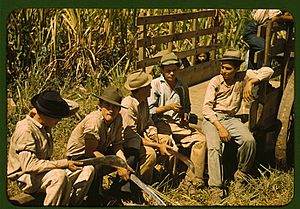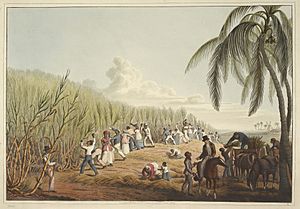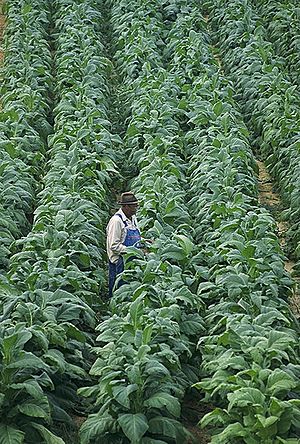Plantation economy facts for kids
A plantation economy is a type of economy where large farms, called plantations, grow a lot of one or two main crops. These crops are usually sold to other countries to make money. Think of it like a giant farm that specializes in growing one thing, like cotton or sugar, to sell.
Some common crops grown on plantations included cotton, rubber, sugar cane, tobacco, rice, and plants used to make indigo dye.
Plantations work best when the crops need a lot of processing right after they are picked. Crops like sugar cane, tea, and palm oil are good examples. Growing these crops on a large scale helps reduce the cost of processing each unit.
Contents
What Makes a Plantation Economy?
Plantation economies are like big factories for farming. They are usually owned by large companies or wealthy people. Even though they are big, it can be hard to manage all the workers across such a large area.
However, if the plantations are far from where the crops will be sold, processing the crops right away can make them smaller and lighter. This helps save money on shipping. For example, turning sugar cane into sugar makes it much easier to transport.
Large plantations can also afford expensive machines for processing their crops. This makes the cost of processing each bit of crop much lower. This works especially well for tropical crops that can be harvested all year round, keeping the machines busy.
Plantations in North America
In the early days of the Thirteen Colonies (which later became part of the United States), plantations were mostly found in the Southern colonies. These included Maryland, Virginia, North Carolina, South Carolina, and Georgia. This area had great soil and long growing seasons, which were perfect for crops like rice and tobacco. Plus, there were many rivers and waterways, making it easy to transport goods. Each colony often focused on one or two main crops.
Slavery on Plantations
Plantation owners started using enslaved people mainly because other types of workers became too expensive. At first, some workers were indentured servants, meaning they worked for a period of time to pay off a debt. But many of them left to start their own farms because land was available. Colonists also tried to use Native Americans for labor, but many of them got sick and died from European diseases.
Because of this, plantation owners turned to enslaved Africans for labor. These people were forcibly brought from Africa. By 1750, a large number of enslaved Africans lived in the Southern colonies. They made up about 40 percent of the population in the South.
Before the Civil War, about one-third of families in the Southern states owned enslaved people. In some states like Mississippi and South Carolina, nearly half of the families did. On very large plantations, the value of the enslaved people was often worth more than the land and farming tools combined.
The first plantations started in the Caribbean islands, like Hispaniola, in the early 1500s. This system, based on forced labor, then spread to places like Mexico, Brazil, and the Southern colonies in North America. At first, some Native Americans were enslaved, but later, most enslaved people were brought from Africa. The growth of plantations led to a huge increase in the Atlantic slave trade.
The demand for cotton from Europe grew a lot in the mid-1800s, causing plantations in the southern United States to expand even more. This system eventually changed from relying completely on enslaved labor to using mostly low-paid workers, though some forced labor continued.
The Atlantic Slave Trade
Enslaved Africans were taken from Africa by European slave traders and shipped across the Atlantic Ocean to the Americas. This terrible journey was called the "middle passage". It was one part of a larger system called the triangular trade, which connected Europe, the Americas, and Africa.
It's believed that about ten million Africans were brought to the Americas. Most of them went to the Caribbean and South America. Only about 6% ended up in the North American colonies. Many people died during the journey because of disease and terrible conditions on the slave ships. They were packed tightly together, leading to sickness and death.
As plantation economies grew, the demand for more enslaved workers increased, which made the slave trade grow even larger.
Europe's Industrial Revolution
Western Europe was the main place where plantation products were sent. At that time, Europe was going through the Industrial Revolution, meaning they were building many factories and needed lots of raw materials to make goods. Europe used the resources and people from the Americas and Africa to help its industries grow. Africa provided enslaved people for the plantations, and the Americas produced raw materials. Europe then sold its manufactured goods, which were worth more, back to Africa and the Americas.
Sugar Plantations

Sugar has been a major plantation crop for a very long time. Growing sugar cane needed a very specific and organized system to make a profit. Sugar plantations always needed a lot of workers, often enslaved, because many workers died due to the harsh conditions.
The enslaved people working on sugar plantations faced endless, hard work year after year. Sugar cane is harvested about 18 months after it's planted. Plantations would divide their land to be efficient: one part resting, one part growing cane, and one part being harvested.
During the rainy season (December to May), workers planted, added animal waste to fertilize the soil, and removed weeds. From January to June, they harvested the cane by chopping it close to the ground, stripping the leaves, and cutting it into shorter pieces to send to the sugar cane mill.
At the mill, the cane was crushed to get the juice. This juice was then boiled until it turned into sugar crystals. Some plantations also went a step further and made rum from the molasses, which is the liquid left after the sugar is made. The sugar was then shipped back to Europe. For the enslaved workers, this difficult routine started all over again.
After slavery was ended in the 1800s, plantations continued to grow sugar cane. However, sugar beets, which can grow in cooler climates, started to take a bigger share of the sugar market.
Indigo Plantations
Indigofera was an important crop in the 1700s, grown in places like Venezuela, Guatemala, and Haiti. It was used to make blue indigo dye before factories started making dyes.
Later, in the 1900s, Mahatma Gandhi investigated how indigo workers in India were being treated unfairly. His work led to a new law in 1917 that helped protect these workers.
Plantations in Southeast Asia
In Southeast Asia, British and Dutch colonies set up plantations to grow crops like tea, pepper, spices, palm oil, coffee, and rubber. Even today, large-scale farming continues in many of these areas.



